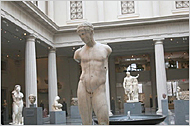The other day, apropos of the Metropolitan Museum’s fine, new light-washed galleries for Greek and Roman art, a friend e-mailed to me a passage by Virgil. In it Aeneas, fleeing the Trojan War, arrives in Carthage and finds a temple for Juno under construction. He pushes open the temple’s big bronze doors (“which made the hinges groan,” Virgil reports) and “for the first time he dared to hope for life.” He’s astounded by the skill of the craftsmen and by the nobility and precision of a painting of the war. He starts to cry.
Interactive Graphic
The Met's New Greek and Roman Galleries
A look inside the new space, with panoramic views of the sculptures, with narration by Michael Kimmelman, the Times's chief art critic.

Statues of the Three Graces from the second century A.D., foreground, and Venus first or second century A.D., center, are among the Roman works featured in the refurbished spaces of the Metropolitan Museum of Art. More Photos »
“It was only a picture, but, sighing deeply, he let his thoughts feed on it, and his face was wet with a stream of tears,” Virgil writes.
The power of ancient art has to do with its ability, as my friend put it, “to embody great acts and communicate their human dimension.” Rome became the model for Western culture from the Renaissance through the Enlightenment.
I’m not sure exactly when its pre-eminence began to fade, but in 1949 a young, populist Met director named Francis Henry Taylor decided to turn the Roman court, the literal and symbolic climax of the building’s southern wing, into a restaurant, which devolved into a cafeteria. Plenty of New Yorkers grew up learning from this arrangement that eating a nutted cheese sandwich at Chock full o’Nuts before going to the museum was a thriftier option than buying a tuna sandwich once you got there.
It was a life lesson, just not the kind that Virgil wrote about.
Fortunately, now, beside the humongous column from the Temple of Artemis at Sardis, which marked the entrance to the cafeteria, where mobs used to crane their necks looking not like Aeneas for hope and inspiration but for the beef stew, you can instead gaze up at huge architectural fragments from the same temple, including one with the sort of egg-and-dart molding that inspired the Met’s facade by Richard Morris Hunt.
Like countless public institutions in America, the Met aped Rome because Rome stood for civic order, empire and reason. Greek and Roman art weren’t the only historic arts of consequence, a lesson the museum taught long before it became fashionable to disparage classical culture. But Rome was a standard against which to measure other cultures, including our own.
Western artists always had, from Michelangelo, who aspired to equal the Belvedere torso, to Picasso, whose “Woman in White” at the Met is unimaginable without classical art. Going from the Greek and Roman galleries to the Picasso is something you can only do there. Willem de Kooning and Arshile Gorky used to haunt these galleries during the 1930s and ’40s and loved the Pompeiian frescoes, whose influence you can see in their works, not far away.
Those frescoes, from luxurious ancient villas on the Bay of Naples, have been cleaned and moved from the museum lobby, where tourists used to mistake them for the coat-check concession. They are reinstalled next to the Roman court, where they look magnificent. I hadn’t noticed until lately all the phalluses on the rooftops of the fantasy buildings, painted in cinnabar and blue, which decorate the murals from a bedroom buried by Vesuvius. The opulence of these scenes suggests something of what inspired Aeneas.
The court, with its burbling fountain, is the centerpiece of the new galleries, which officially open today, and it’s a terrific gift to New York, a vast, skylighted, airy new public space, chilly with all the newly scrubbed marble and naked light but aptly lofty.
Video
More Video »It would be wrong to say that everything on view is wonderful. There are garden-variety sculptures from Roman baths and archaeological fragments more meaningful to specialists than to the rest of us, along with imperial portrait busts, funerary reliefs and the Badminton sarcophagus, whose reputation belies the fact that it’s a bit over the top. The Met’s Greek and Roman collection is enormous but not like the collections in Athens, Rome, Naples, London, Paris or Berlin, built around stupendous masterworks.
You can say, though, that it tells the whole story. With the Greek galleries, finished eight years ago, Western antiquity from the Bronze Age through the reign of Constantine now unfolds in logical, stately order, as was intended from the museum’s early days. Thousands of objects have been exhumed from storage (it’s about time) and animated by new touch-screen computers (useful up to a point) and by air and sun.
In total there are 57,000 square feet of exhibition space for classical antiquity, around 30,000 for Rome alone, equivalent to all the galleries at the Whitney Museum combined. You can exit Rome into African art then go directly into modern art, which depended on both Rome and Africa for utterly different ideas about the human body.
- 1
- 2















